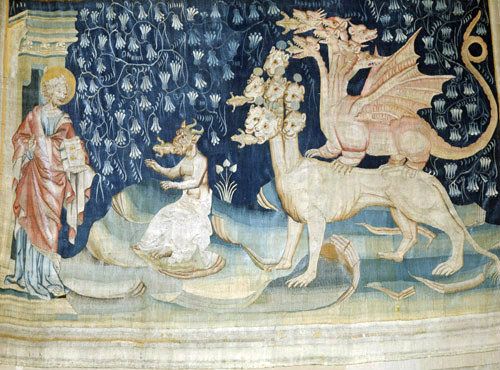
Louis I duke of Anjou, designed by Jean Bondol (Chateau d’Angers, France).
The sixth [angel] poured out his bowl on the great river, the Euphrates, and its water was dried up, to prepare a way for the kings…. Then I saw coming from the mouth of the dragon, from the mouth of the beast, and from the mouth of the false prophet three foul spirits like frogs…. “Behold, I come like a thief!” Blessed is he that stays awake and keeps his garments by him, so that he does not walk naked and his shame is seen. And they mustered them at the place which is called in Hebrew, “Armageddon.” (Apoc. 16:12-13, 15-16)
Almost everyone recognizes the place-name, Armageddon. It is imagined to be the location of the last battle–or maybe the nuclear war–that destroys the world. But very few people know anything more than that.
“Armageddon” means “the mountain of Megiddo.” This is a mountain pass in the north of Israel that makes possible passage from the coast to the plain of Jezreel. It is a geographic feature important for military-strategic reasons. Many battles were fought at Armageddon; it was especially associated with disaster after the death of King Josiah there (2 Kings 23:29-30).
Armageddon is also important in the Old Testament book of Judith, which is an extended parable about God’s deliverance of his Chosen People. (We think of parables as only a few sentences–or at most, a paragraph or two–because Jesus’ parables were all short. But there is no composition rule that insists that a parable has to be short.)
It is also interesting that the Old Testament readings generally called “prophecies” by Western Christians on Easter Eve or other significant occasions are called “parables” in Church Slavonic.
Judith lives in an imaginary town near the Armageddon pass. By placing the town there, the people hearing the parable would immediately know that the story of Judith was about the End of Days, the great Last Battle when they hoped that God would deliver his people from all their enemies. The people hearing the story of Judith knew that it was not history as we think of history. It was never meant to be understood as an historical record. It was a parable: a story told to make a point, to illustrate something true that was otherwise difficult to grasp or understand. The story of Judith at Armageddon is like the story of Moses at the Red Sea–God acts in a miraculous way to save his people through the intervention of his chosen servant. Judith is a female figure that represents the faithful of Israel, identified by the prophets as the Bride of God.
Because the enemies of Israel almost always have to come through the northern mountain pass at Armageddon to attack Israel, the direction North became associated with evil and the powers that oppose God or his people. That is why the medieval Western Christians would read the Gospel at High Mass facing north–both to proclaim the Gospel to the pagans living far in the north but also to proclaim God’s triumph over all the powers that oppose him. Reading the Gospel facing north was a kind of exorcism of the neighborhood, telling the devil to “Go away! You have no business here, devil! You have already been defeated by Christ–stop trying to avoid your inevitable imprisonment in Hell!”
When St. John described the battle at Armageddon, he might or might not have thought people would identify the earthly mountain pass as the place of the Last Battle. But they would certainly understand that wherever the Last Battle was to be fought would be “Armageddon” in a much more real and substantial way than the mountain in northern Israel.
See a talk I gave about Judith here. The passcode to view the recording is 2w$Pq&6e
